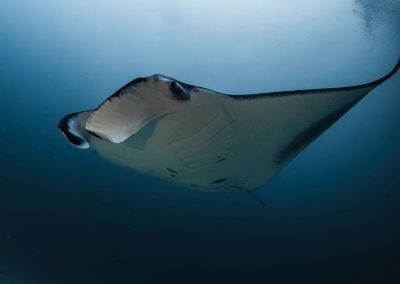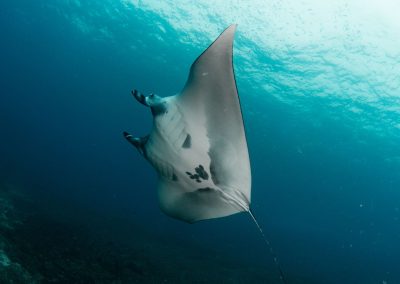Although they may look similar to the untrained eye, manta rays and stingrays live completely different lives. One spends its days gliding through the open ocean, feeding on clouds of plankton, while the other lies low on the seafloor, hunting small prey and relying on a venomous barb for defense.
Both mantas and sting rays belong to the subclass of cartilaginous fish called elasmobranchs, which also includes sharks and skates. Manta rays currently include three recognized species: the reef manta (Mobula alfredi), the giant oceanic manta (Mobula birostris), and the Atlantic manta (Mobula yarae). The group of stingrays is much larger and more varied, and includes dozens of species found in oceans and freshwater habitats worldwide.
There’s a common misconception that all rays are dangerous, especially since the 2006 freak accident in which wildlife presenter Steve Irwin was killed by a stingray. However, manta rays have no stinger and pose no threat to humans.
Lifestyle and habitat of the manta ray vs the sting ray
Mantas and stingrays may share a flattened body shape and common ancestors, but their daily lives couldn’t be more different.
Manta rays are ocean wanderers. They live in open water and coastal areas where they can feed on plankton. Reef manta rays and Atlantic mantas tend to stay closer to shore, often visiting cleaning stations where small fish remove parasites from their skin; pelagic mantas travel long distances in the open ocean, following seasonal plankton blooms. You’ll usually see mantas swimming in the water column and sometimes even jumping out of the water (a phenomenon called “breaching”), but never resting on the bottom.
There’s a simple explanation: mantas keep swimming at all times because they need a constant flow of water over their gills to breathe. The need for perpetual motion is something they’ve got in common with their distant cousins, the sharks. Their wide, wing-like pectoral fins make them graceful and efficient travellers, able to cover great distances in search of food.
Stingrays live a very different life. They are bottom-dwellers, spending much of their time resting on sandy or muddy seafloors. Many species of sting rays bury themselves under a thin layer of sand with just their eyes and spiracles (breathing openings) exposed. This helps them ambush prey and avoid predators. Unlike mantas, stingrays can pump water over their gills while still, which allows them to breathe even when completely buried.
The different diets of mantas and sting rays
One of the most apparent differences between manta and sting rays is how they feed.
Manta rays are filter feeders and eat zooplankton: tiny drifting organisms such as copepods, mysid shrimp, and fish larvae. They can consume around 12% of their body weight in plankton each week, which for a 1,000-pound manta amounts to roughly 120 pounds of plankton. To capture their microscopic prey, mantas swim with their mouths open, using their cephalic fins (the horn-like flaps on their heads) to guide plankton-rich water in. Inside the mouth, comb-like structures called gill rakers strain out the food while letting water flow over the gills. Read more about the mechanics of filter-feeding here!
Stingrays, on the other hand, are active hunters with a completely different approach. They search along the bottom for small fish, crabs, shrimp, mollusks, and worms. They locate hidden prey by using their acute sense of smell and ability to detect the faint electrical signals that living animals make. They then use their strong, plate-like teeth to crush shells and get to the meat inside. Many stingray species lie still and partially buried until something edible comes within range, then lunge forward to grab it.
Manta ray vs stingray anatomy
Although manta rays and stingrays share the same basic body shape, their anatomy reflects their two very different ways of life.
Manta rays are among the largest fish in the ocean. Reef mantas usually measure 11–14 feet (3.5–4.3 m) across, while oceanic/pelagic mantas can exceed 20 feet (6 m) from wingtip to wingtip, earning them the name “giant manta”. Their bodies are streamlined for efficiency, with wide, triangular pectoral fins to propel them through open water. Their mouths are set at the front of their heads (ideal for filter feeding while swimming forward) and flanked by cephalic fins, which unroll to funnel plankton-rich water in. Their long, thin tails are harmless; unlike sting rays, they don’t have a stinger or barb.
Stingrays range widely in size, from small species just a few inches across to the giant freshwater stingray, which can measure up to 7 feet (2 m). Their bodies are more rounded than those of manta rays, adapted for life close to the seafloor. The mouth is located underneath, allowing them to feed on bottom-dwelling prey, and their pectoral fins undulate in a rippling motion that helps them move along the substrate. Many species have one or more venomous barbs on their tail for defense. These barbs are serrated, coated with venom, and capable of causing painful injuries if a ray feels threatened.
If you’d like to see how manta rays and stingrays compare to their other close relatives, check out our comparison between mantas, stingrays, and eagle rays.
Behavior and defense mechanisms
Manta rays and stingrays not only live in different parts of the ocean, but they also behave in completely different ways.
Despite their size, manta rays are known for their calm and curious nature. Thanks to the manta’s size and agility, combined with acrobatic maneuverability, they simply swim away when they feel threatened. They can move very fast and outrun their main predators, which are tiger sharks in Hawaiian waters. Mantas have never been known to cause serious injury to a person. Their peaceful nature earned them the nickname “gentle giants”, which is also why swimming with them is considered completely safe when done with caution and respecting basic safety guidelines.
Stingrays spend much of their time resting on or buried in the seafloor, camouflaged to avoid predators and capture prey. When disturbed, most will simply swim away; but if they feel cornered, they can defend themselves with a whip of the tail.
This defensive behaviour is what led to the 2006 freak accident in which Australian celebrity Steve Irwin was killed by a short-tailed stingray. He startled the animal, which struck with its barb… directly into Irwin’s heart. Despite this tragic incident, stingray injuries are uncommon, and fatalities are extremely rare.
Sting rays vs manta rays: conservation status
Manta rays face bigger challenges around the world than stingrays. Reef manta rays are listed as vulnerable and giant oceanic mantas as endangered on the IUCN Red List. This is partly because they reproduce slowly; a female gives birth to just one pup every two to five years, which means populations can’t quickly recover from losses.
Overfishing, entanglement in fishing gear, habitat degradation, and pollution are major threats to these gentle giants. In some parts of the world, mantas are still targeted for their gill rakers, which are sold for use in traditional medicine despite having no proven health benefits.
→ Read more about the threats that manta rays face and how we can protect them
Most stingray species are not currently considered threatened, though some face local declines due to habitat destruction, overfishing, or pollution. Their faster reproduction rates and adaptability generally make them more resilient to human impacts.
If you’d like to help protect manta rays and ensure that encounters with them remain possible for future generations, please support sustainable manta tourism and wider ocean conservation efforts.
Frequently asked questions about manta rays vs stingrays
Do all rays have stingers?
No. While many stingray species have one or more venomous barbs on their tails, manta rays, devil rays, and some other ray species have no stinger at all.
Do manta rays sting?
No. Manta rays don’t have a stinger or any other defensive weapon. They pose no threat to humans and are often called “gentle giants” because of their peaceful nature.
Are manta rays and stingrays the same?
No. They’re both types of rays, but they belong to different classes within the ray family. Mantas live in open water and filter-feed on plankton, while stingrays are bottom-dwellers that hunt small prey and use their stinger only for defense.
Manta rays vs sting rays in a snapshot
Manta rays and stingrays share a distant family connection, but their lives, diets, and behaviors are worlds apart.
Mantas are plankton-eating travellers of the open ocean, with no stinger and a calm, curious nature. Stingrays are bottom-dwelling hunters, equipped with a defensive barb they use only when threatened.
Manta rays are nicknamed “gentle giants of the ocean” and pose no threat to people; and with a little awareness, encounters with stingrays can be safe too. In shallow water, a simple “stingray shuffle” is usually enough to avoid startling them.
To see the differences for yourself, watch our manta vs stingray comparison video below!














0 Comments